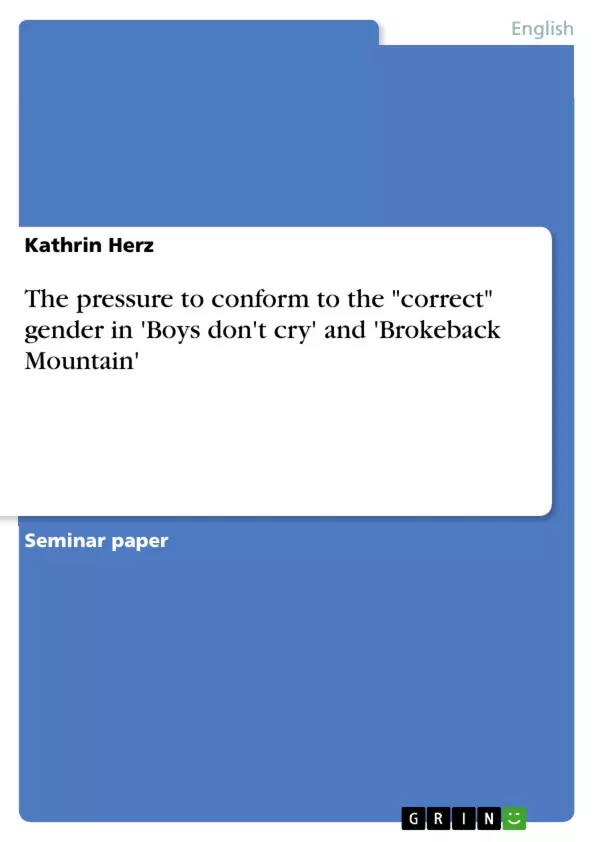Even nowadays people who do not fit in the commonly accepted sexual role models of our society still face severe problems and hostilities which frequently culminate in murder. This is illustrated in the movies Boys don’t cry (1999) and Brokeback Mountain (2005). The two low-budged productions by the directors Kimberly Peirce and Ang Lee both tell love stories that are not blessed by society. The individuals suffer the pressure to conform to what is regarded as the “correct gender” in the respective societies.
But what is meant by “correct gender”? “Gender”, as García Landa defines it, is a “matter of language, of signs and symbols”. It is a social construct and refers to the “cultural representation of sexual difference”. In practice it can not be seen completely detached from biological sex as its definition is partly based on features as for example social behaviour and clothing commonly attributed to one certain sex. Also, sexual identity, which refers to the sexual orientation, is closely linked to gender because it is constructed on the basis of selfsame. The term “correct gender” refers to what society generally expects from a certain sex, in other words a person who biologically is a man should also conform to the male gender. As in all cultures individuals are socialized into a dominant heterosexual eroticism this includes having a heterosexual orientation.
The aim of this paper is to analyze how the societies where the pressure originates from are built, how the characters cope with or try to escape from or strengthen the pressure to conform to the “correct gender”, and which consequences this has. Also, on a structural level, the cinematographic means and techniques which the directors use will be analyzed in the course of the paper.
When quoting from the film minutes will be stated in parenthesis after the quotation. The analysis in chapter 3.1. is taken from the audio commentary of director Kimberly Pierce which is included on the DVD Boys don’t cry.
Inhaltsverzeichnis (Table of Contents)
- Introduction
- Society in Boys don't cry and Brokeback Mountain
- Society's Pressure and Reactions to It
- Boys don't cry
- Teena Brandon or Brandon Teena
- Lana Tisdel
- John Lotter
- Brokeback Mountain
- Jack Twist
- Ennis Del Mar
- Boys don't cry
- Brokeback Mountain as a Symbol
Zielsetzung und Themenschwerpunkte (Objectives and Key Themes)
This paper aims to examine how the societies portrayed in the films Boys don't cry and Brokeback Mountain contribute to the pressure individuals face to conform to "correct gender" roles. It explores how the characters navigate this pressure, their coping mechanisms, and the consequences of their choices. The paper also analyzes the cinematic techniques employed by the directors to convey these themes.
- The societal pressure to conform to traditional gender roles and the consequences of deviating from these norms
- The portrayal of love and relationships that challenge societal expectations
- The role of violence and prejudice in perpetuating societal norms
- The impact of rural environments and social isolation on individual identity and choices
- The use of cinematic techniques to depict emotional and psychological struggles
Zusammenfassung der Kapitel (Chapter Summaries)
The introduction sets the stage by discussing the societal pressure to conform to "correct gender" roles and introduces the films Boys don't cry and Brokeback Mountain as examples of how this pressure can lead to extreme consequences. The paper defines "gender" as a social construct and explores the term "correct gender" in the context of heterosexual dominance.
Chapter 2 examines the societal contexts of the films, focusing on the shared themes of rural environments, working-class characters, and the prevalence of violence, prejudice, and intolerance. The chapter analyzes the specific social pressures faced by Brandon Teena in Boys don't cry and the characters in Brokeback Mountain.
Chapter 3 delves deeper into the characters' experiences with societal pressure. It explores how Teena Brandon's journey, Lana Tisdel's support, and John Lotter's actions reflect the prevailing attitudes and reactions to gender nonconformity. It further analyzes the characters of Jack Twist and Ennis Del Mar, emphasizing the challenges they face in a society that does not accept their love.
Chapter 4 discusses the symbolic significance of Brokeback Mountain, focusing on its portrayal of the characters' internal struggles and the limitations imposed by societal expectations.
Schlüsselwörter (Keywords)
The key themes and concepts of the paper include gender, social pressure, conformity, nonconformity, societal expectations, violence, prejudice, love, relationships, rural environments, working-class characters, cinematic techniques, and the films Boys don't cry and Brokeback Mountain. The paper explores the societal pressures faced by individuals who challenge traditional gender roles and examines the consequences of deviating from these norms.
- Quote paper
- Kathrin Herz (Author), 2006, The pressure to conform to the "correct" gender in 'Boys don't cry' and 'Brokeback Mountain', Munich, GRIN Verlag, https://www.grin.com/document/67387



